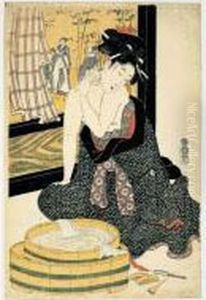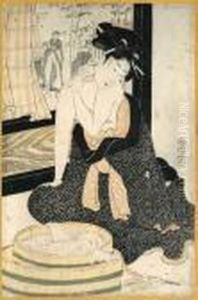Tamagawa Shucho Paintings
Tamagawa Shucho was an Edo period Japanese painter, born in 1739 and passed away in 1823. Although not as widely recognized as some of his contemporaries in the broader narrative of Japanese art history, Shucho made significant contributions through his artistic works during the Edo period, a time characterized by relative peace, political stability, and economic growth in Japan under the rule of the Tokugawa shogunate.
Shucho was active during a culturally rich era that saw the development and maturation of ukiyo-e, a genre of woodblock prints and paintings that depicted the 'floating world'—the pleasure quarters and theater districts of urban Japan. Ukiyo-e artists like Shucho often portrayed subjects from the kabuki theater, the pleasure districts, sumo wrestlers, and landscapes, as well as scenes from history and folk tales.
Shucho's style was influenced by the dominant artistic trends of his time. He was particularly known for his bijinga, or pictures of beautiful women, which were a popular ukiyo-e theme. These works often depicted the courtesans and geishas of the pleasure quarters with stylized features and elegant postures. Like many ukiyo-e artists, Shucho paid great attention to details of clothing and hairstyle, which were not only aesthetically pleasing but also conveyed information about the status and personality of the subjects.
While details about his personal life and training are scarce, it is likely that Shucho was part of a community of artists who shared techniques and ideas, contributing to the evolution of the ukiyo-e style. His works would have been disseminated primarily in the form of woodblock prints, a process that involved collaboration with skilled carvers and printers who could translate the artist's designs into mass-produced images.
Tamagawa Shucho's legacy, like that of many ukiyo-e artists, is preserved through the prints and paintings that survive him. These works continue to offer insight into the cultural life of Edo Japan and contribute to our understanding of the era's aesthetics and social customs. His death in 1823 marked the end of a career that spanned a golden age of Japanese art, and his contributions remain a part of the rich tapestry of Japan's artistic heritage.

